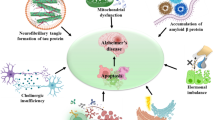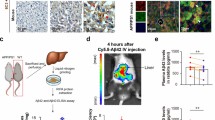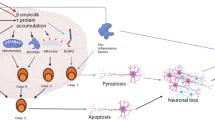Abstract
Here we demonstrate for the first time that cannabidiol (CBD) acts to protect synaptic plasticity in an in vitro model of Alzheimer’s disease (AD). The non-psycho active component of Cannabis sativa, CBD has previously been shown to protect against the neurotoxic effects of beta amyloid peptide (Aβ) in cell culture and cognitive behavioural models of neurodegeneration. Hippocampal long-term potentiation (LTP) is an activity dependent increase in synaptic efficacy often used to study cellular mechanisms related to memory. Here we show that acute application of soluble oligomeric beta amyloid peptide (Aβ1–42) associated with AD, attenuates LTP in the CA1 region of hippocampal slices from C57Bl/6 mice. Application of CBD alone did not alter LTP, however pre-treatment of slices with CBD rescued the Aβ1–42 mediated deficit in LTP. We found that the neuroprotective effects of CBD were not reversed by WAY100635, ZM241385 or AM251, demonstrating a lack of involvement of 5HT1A, adenosine (A2A) or Cannabinoid type 1 (CB1) receptors respectively. However in the presence of the PPARγ antagonist GW9662 the neuroprotective effect of CBD was prevented. Our data suggests that this major component of Cannabis sativa, which lacks psychoactivity may have therapeutic potential for the treatment of AD.





Similar content being viewed by others
References
Hardy J, Allsop D (1991) Amyloid deposition as the central event in the aetiology of Alzheimer’s disease. Trends Pharmacol Sci 12(10):383–388
Holtzman DM et al (2000) Apolipoprotein E isoform-dependent amyloid deposition and neuritic degeneration in a mouse model of Alzheimer’s disease. Proc Natl Acad Sci U S A 97(6):2892–2897
Mc Donald JM et al (2010) The presence of sodium dodecyl sulphate-stable Aβ dimers is strongly associated with Alzheimer-type dementia. Brain 133(5):1328–1341
Enya M et al (1999) Appearance of sodium dodecyl sulfate-stable amyloid beta-protein (Aβ) dimer in the cortex during aging. Am J Pathol 154(1):271–279
Roher AE et al (1996) Morphology and toxicity of Aβ-(1–42) dimer derived from neuritic and vascular amyloid deposits of Alzheimer’s disease. J Biol Chem 271(34):20631–20635
Vigo-Pelfrey C et al (1993) Characterization of beta-amyloid peptide from human cerebrospinal fluid. J Neurochem 61(5):1965–1968
Bliss TV, Collingridge GL, Morris RG (2014) Synaptic plasticity in health and disease: introduction and overview. Philos Trans R Soc Lond B Biol Sci 369(1633):20130129
Metais C et al (2014) Simvastatin treatment preserves synaptic plasticity in AβPPswe/PS1dE9 mice. J Alzheimers Dis 39(2):315–329
Costello DA, O’Leary DM, Herron CE (2005) Agonists of peroxisome proliferator-activated receptor-gamma attenuate the Aβ-mediated impairment of LTP in the hippocampus in vitro. Neuropharmacology 49(3):359–366
Lauren J et al (2009) Cellular prion protein mediates impairment of synaptic plasticity by amyloid-beta oligomers. Nature 457(7233):1128–1132
Freir DB et al (2011) Interaction between prion protein and toxic amyloid beta assemblies can be therapeutically targeted at multiple sites. Nat Commun 2:336
Nicoll AJ et al (2013) Amyloid-beta nanotubes are associated with prion protein-dependent synaptotoxicity. Nat Commun 4:2416
Cheng D et al (2014) Chronic cannabidiol treatment improves social and object recognition in double transgenic APPswe/PS1∆E9 mice. Psychopharmacology 231(15):3009–3017
Iuvone T et al (2004) Neuroprotective effect of cannabidiol, a non-psychoactive component from Cannabis sativa, on beta-amyloid-induced toxicity in PC12 cells. J Neurochem 89(1):134–141
Krishnan S, Cairns R, Howard R (2009) Cannabinoids for the treatment of dementia. Cochrane Database Syst Rev 2: CD007204
Booz GW (2011) Cannabidiol as an emergent therapeutic strategy for lessening the impact of inflammation on oxidative stress. Free Radic Biol Med 51(5):1054–1061
Martin-Moreno AM et al (2011) Cannabidiol and other cannabinoids reduce microglial activation in vitro and in vivo: relevance to Alzheimer’s disease. Mol Pharmacol 79(6):964–973
Esposito G et al (2006) Cannabidiol inhibits inducible nitric oxide synthase protein expression and nitric oxide production in beta-amyloid stimulated PC12 neurons through p38 MAP kinase and NF-kappaB involvement. Neurosci Lett 399(1–2):91–95
Esposito G et al (2011) Cannabidiol reduces Aβ-induced neuroinflammation and promotes hippocampal neurogenesis through PPARγ involvement. PLoS ONE 6(12):e28668
Laprairie RB et al (2015) Cannabidiol is a negative allosteric modulator of the cannabinoid CB1 receptor. Br J Pharmacol 172(20):4790–4805
Vallee A et al (2017) Effects of cannabidiol interactions with Wnt/beta-catenin pathway and PPARγ on oxidative stress and neuroinflammation in Alzheimer’s disease. Acta Biochim Biophys Sin (Shanghai) 49(10):853–866
Ledgerwood CJ et al (2011) Cannabidiol inhibits synaptic transmission in rat hippocampal cultures and slices via multiple receptor pathways. Br J Pharmacol 162(1):286–294
Zanelati TV et al (2010) Antidepressant-like effects of cannabidiol in mice: possible involvement of 5-HT1A receptors. Br J Pharmacol 159(1):122–128
Resstel LB et al (2009) 5-HT1A receptors are involved in the cannabidiol-induced attenuation of behavioural and cardiovascular responses to acute restraint stress in rats. Br J Pharmacol 156(1):181–188
Campos AC, Guimaraes FS (2008) Involvement of 5HT1A receptors in the anxiolytic-like effects of cannabidiol injected into the dorsolateral periaqueductal gray of rats. Psychopharmacology 199(2):223–230
Ribeiro A et al (2012) Cannabidiol, a non-psychotropic plant-derived cannabinoid, decreases inflammation in a murine model of acute lung injury: role for the adenosine A(2A) receptor. Eur J Pharmacol 678(1–3):78–85
Liou GI et al (2008) Mediation of cannabidiol anti-inflammation in the retina by equilibrative nucleoside transporter and A2A adenosine receptor. Invest Ophthalmol Vis Sci 49(12):5526–5531
O’Sullivan SE et al (2009) Time-dependent vascular actions of cannabidiol in the rat aorta. Eur J Pharmacol 612(1–3):61–68
McPartland JM, Glass M, Pertwee RG (2007) Meta-analysis of cannabinoid ligand binding affinity and receptor distribution: interspecies differences. Br J Pharmacol 152(5):583–593
Thomas A et al (2007) Cannabidiol displays unexpectedly high potency as an antagonist of CB1 and CB2 receptor agonists in vitro. Br J Pharmacol 150(5):613–623
Bisogno T et al (2001) Molecular targets for cannabidiol and its synthetic analogues: effect on vanilloid VR1 receptors and on the cellular uptake and enzymatic hydrolysis of anandamide. Br J Pharmacol 134(4):845–852
Carrier EJ, Auchampach JA, Hillard CJ (2006) Inhibition of an equilibrative nucleoside transporter by cannabidiol: a mechanism of cannabinoid immunosuppression. Proc Natl Acad Sci USA 103(20):7895–7900
Forster EA et al (1995) A pharmacological profile of the selective silent 5-HT1A receptor antagonist, WAY-100635. Eur J Pharmacol 281(1):81–88
Dall’Igna OP et al (2003) Neuroprotection by caffeine and adenosine A2A receptor blockade of beta-amyloid neurotoxicity. Br J Pharmacol 138(7):1207–1209
Leesnitzer LM et al (2002) Functional consequences of cysteine modification in the ligand binding sites of peroxisome proliferator activated receptors by GW9662. Biochemistry 41(21):6640–6650
Ryan D et al (2009) Cannabidiol targets mitochondria to regulate intracellular Ca2+ levels. J Neurosci 29(7):2053–2063
Shankar GM et al (2007) Natural oligomers of the Alzheimer amyloid-beta protein induce reversible synapse loss by modulating an NMDA-type glutamate receptor-dependent signaling pathway. J Neurosci 27(11):2866–2875
Pugliese AM, Passani MB, Corradetti R (1998) Effect of the selective 5-HT1A receptor antagonist WAY 100635 on the inhibition of e.p.s.ps produced by 5-HT in the CA1 region of rat hippocampal slices. Br J Pharmacol 124(1):93–100
Thomas BF et al (1998) Comparative receptor binding analyses of cannabinoid agonists and antagonists. J Pharmacol Exp Ther 285(1):285–292
Hoffman AF et al (2010) Control of cannabinoid CB1 receptor function on glutamate axon terminals by endogenous adenosine acting at A1 receptors. J Neurosci 30(2):545–555
Pertwee RG (2008) The diverse CB1 and CB2 receptor pharmacology of three plant cannabinoids: ∆9-tetrahydrocannabinol, cannabidiol and ∆9-tetrahydrocannabivarin. Br J Pharmacol 153(2):199–215
Martinez-Pinilla E et al (2017) Binding and signaling studies disclose a potential allosteric site for cannabidiol in cannabinoid CB2 receptors. Front Pharmacol 8:744
de Mendonça A, Ribeiro JA (2001) Adenosine and synaptic plasticity. Drug Dev Res 52(1–2):283–290
Rombo DM et al (2015) Synaptic mechanisms of adenosine A2A receptor-mediated hyperexcitability in the hippocampus. Hippocampus 25(5):566–580
Hasko G, Cronstein BN (2004) Adenosine: an endogenous regulator of innate immunity. Trends Immunol 25(1):33–39
Castillo A et al (2010) The neuroprotective effect of cannabidiol in an in vitro model of newborn hypoxic-ischemic brain damage in mice is mediated by CB2 and adenosine receptors. Neurobiol Dis 37(2):434–440
Slanina KA, Roberto M, Schweitzer P (2005) Endocannabinoids restrict hippocampal long-term potentiation via CB1. Neuropharmacology 49(5):660–668
Karl T et al (2012) The therapeutic potential of the endocannabinoid system for Alzheimer’s disease. Expert Opin Ther Targets 16(4):407–420
Mazzola C, Micale V, Drago F (2003) Amnesia induced by beta-amyloid fragments is counteracted by cannabinoid CB1 receptor blockade. Eur J Pharmacol 477(3):219–225
Heneka MT, Landreth GE (2007) PPARs in the brain. Biochim Biophys Acta 1771(8):1031–1045
Bouhlel MA et al (2007) PPARγ activation primes human monocytes into alternative M2 macrophages with anti-inflammatory properties. Cell Metab 6(2):137–143
Jo J et al (2011) Aβ(1–42) inhibition of LTP is mediated by a signaling pathway involving caspase-3, Akt1 and GSK-3β. Nat Neurosci 14(5):545–547
Peineau S et al (2007) LTP inhibits LTD in the hippocampus via regulation of GSK3β. Neuron 53(5):703–717
da Silva VK et al (2014) Cannabidiol normalizes caspase 3, synaptophysin, and mitochondrial fission protein DNM1L expression levels in rats with brain iron overload: implications for neuroprotection. Mol Neurobiol 49(1):222–233
Fagherazzi EV et al (2012) Memory-rescuing effects of cannabidiol in an animal model of cognitive impairment relevant to neurodegenerative disorders. Psychopharmacology 219(4):1133–1140
Esposito G et al (2006) The marijuana component cannabidiol inhibits beta-amyloid-induced tau protein hyperphosphorylation through Wnt/beta-catenin pathway rescue in PC12 cells. J Mol Med (Berl) 84(3):253–258
Cabrero A, Laguna JC, Vazquez M (2002) Peroxisome proliferator-activated receptors and the control of inflammation. Curr Drug Targets Inflamm Allergy 1(3):243–248
Inestrosa NC et al (2005) Peroxisome proliferator-activated receptor gamma is expressed in hippocampal neurons and its activation prevents beta-amyloid neurodegeneration: role of Wnt signaling. Exp Cell Res 304(1):91–104
Author information
Authors and Affiliations
Corresponding author
Rights and permissions
About this article
Cite this article
Hughes, B., Herron, C.E. Cannabidiol Reverses Deficits in Hippocampal LTP in a Model of Alzheimer’s Disease. Neurochem Res 44, 703–713 (2019). https://doi.org/10.1007/s11064-018-2513-z
Received:
Revised:
Accepted:
Published:
Issue Date:
DOI: https://doi.org/10.1007/s11064-018-2513-z




